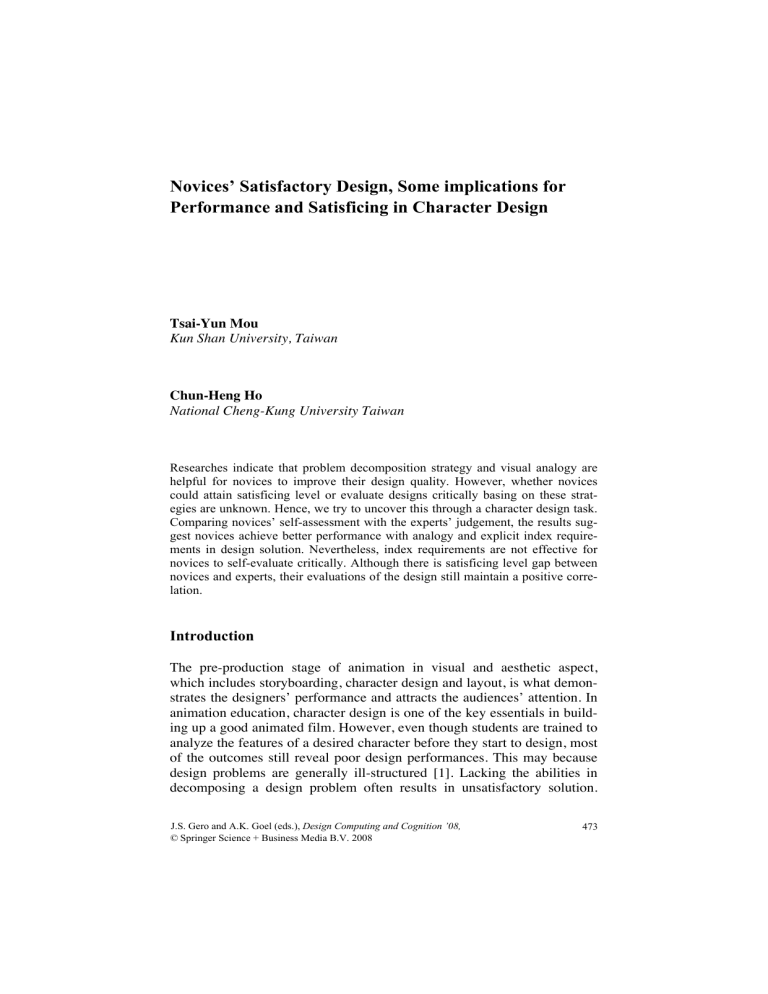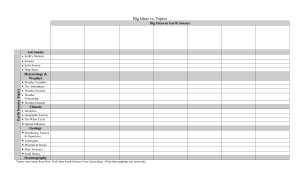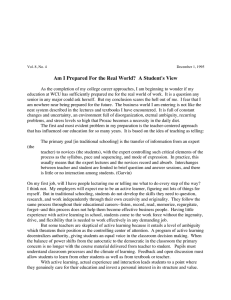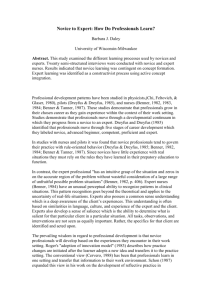Novices’ Satisfactory Design, Some implications for Tsai-Yun Mou Chun-Heng Ho

Novices’ Satisfactory Design, Some implications for
Performance and Satisficing in Character Design
Tsai-Yun Mou
Kun Shan University, Taiwan
Chun-Heng Ho
National Cheng-Kung University Taiwan
Researches indicate that problem decomposition strategy and visual analogy are helpful for novices to improve their design quality. However, whether novices could attain satisficing level or evaluate designs critically basing on these strategies are unknown. Hence, we try to uncover this through a character design task.
Comparing novices’ self-assessment with the experts’ judgement, the results suggest novices achieve better performance with analogy and explicit index requirements in design solution. Nevertheless, index requirements are not effective for novices to self-evaluate critically. Although there is satisficing level gap between novices and experts, their evaluations of the design still maintain a positive correlation.
Introduction
The pre-production stage of animation in visual and aesthetic aspect, which includes storyboarding, character design and layout, is what demonstrates the designers’ performance and attracts the audiences’ attention. In animation education, character design is one of the key essentials in building up a good animated film. However, even though students are trained to analyze the features of a desired character before they start to design, most of the outcomes still reveal poor design performances. This may because design problems are generally ill-structured [1]. Lacking the abilities in decomposing a design problem often results in unsatisfactory solution.
J.S. Gero and A.K. Goel (eds.), Design Computing and Cognition ’08,
© Springer Science + Business Media B.V. 2008
473
474 T-Y. Mou, C-H. Ho
Similar findings that novice does not have a good problem decomposing strategy which results in poor design performance are discussed in a protocol study in industrial design [2].
Studies of the differences between experts and novices are welldiscussed in later researches, in which all point out novices common defects in solving problems [3], [4], and [5]. If decomposition of problems is one critical stage of migrating from novices to experts, then assigning explicitly pre-decomposed problem may lead novices into good enough and satisfactory solutions. Surely, besides problem decomposition, there are also other factors that affect and inhabit in novices’ design cognition [6].
Among these factors, information over-gathering [7] and problem-focused instead of solution-focused [8] are two critical problems existing in character design. These phenomena actually root in the inability of problem decomposition. Without forming up the problem scope and dividing them, novices collect unnecessary information and thus result in low quality works. Also, novices tend to spend too much time on defining the problem, instead of seeing the design problem through relevant solutions from problem structure perspective. Therefore, in this study, problem decomposition ability in novices is the critical part which we will look into.
In addition to problem decomposition, previous studies indicated that even though visual analogy is an integrated design cognition in experts, novices can improve their design quality if they are explicitly required to use this approach [9]. Related researches also suggested that in illstructured design problem, novice designers perform better if analogy, as a high-level problem solving strategy, is utilized [10]. Heylighen [11] studied architecture students’ performance in using case-based reasoning also confirmed positive impact of analogy. Similar approach is actually applied in animation production, including character design and keyframe animation, in which observations of real life are the sources of new creation for designers [12]. Therefore, we would use analogy as the supportive method in achieving better design solutions of the novices.
While visual analogy is a good guideline for novices, their design solutions may not be satisficing , as defined by Simon [13]. In solving a design problem, in which there are lots of complexity and interacting variables, searching for an optimal solution is not a wise decision in terms of time, resources, and returns. Rather than achieving an optimal design, designers search for a satisfactory solution that is better than current situation by improving incrementally.
However, while with novice designers, their inexperience in problem solving might lead to low satisfactory solutions and performances. Nevertheless, satisficing could be interpreted from two perspectives the de-
Novices’ Satisfactory Design 475 signer and the evaluator, that this research will focus on the differences.
Novices’ low satisfactory solutions lie in the fact that they usually settle down on early and instinctive designs without exploring new possibilities
[14], and [15]. Previous research on design misconceptions indicates that
‘fixation’ is novice designers’ common defect [16] and [17]. Therefore, in our study, we are interested in seeing whether requiring novice designers to use visual analogy, without reminding certain decomposed design elements, could also help novice designers to overcome the fixation problem and achieve satisfactory solutions from experts’ points of view.
Objectives and Hypotheses
Based on related literature review in previous section, more fundamentally speaking, here we would like to investigate if novices have good selfassessment abilities and/or if we can improve their self-assessment abilities by reminding them some important design criteria such as problem decomposition and visual analogy. In sum, there are two hypotheses in this study. First, if we explicitly require certain criteria, i.e. problem decomposition and analogy, in design solution, novice designers will have higher satisficing levels and better performances. Second, novices’ satisficing levels will be corresponding with the experts’ evaluations in ratio aspect.
Method
Participants
Eight character design students (3 male, 5 female) regarded as novices participated in this experiment. They were third year undergraduate students and had same training background in sketch and graphic design. Because drawing skill is influential in the representation of design which directly affects the score judgement [18], the selection of participants were refined to meet similar drawing skill level. Thus there were only eight participants in the experiment. Their drawing skills were considered as same level based on their prior assignments’ performance. The participants took this experiment as their final exam and earned credits for their participation.
476 T-Y. Mou, C-H. Ho
Design
There were two experimental conditions within each including four participants. In the test condition, 4 participants were given a character design problem, i.e. a girl character with personality, reference pictures and a task sheet containing general instructions. The index requirements for character design were pose, face, and costume. Participants were requested to achieve these requirements to a satisficing level in their designs. In the control condition, the same problem and instructions were given to the other 4 participants. They were asked to use visual analogy to design a character to a satisficing level without explicitly indicated to meet the index requirements.
The reference pictures contained thirty images, which were divided equally in amount into three categories: figure pose, human/animal face, and costume. The visual references were arranged randomly in order to confound the category similarity in display. Individual copy of image references was given to each participant. In order to achieve satisfactory solution, there was no time limit for solving the problem. Nevertheless, the task duration time of each participant was recorded so as to reveal the correlation between satisfactory solution and problem solving time.
Procedure
The experiment was carried out in one design session with each condition group in different room. After finishing the design problem, each participant met with the experimenter individually to score his or her own design according to the index requirements and the overall design on a given evaluation sheet. The participant was explained that the evaluation would not affect his or her grades in the course. Interview with each participant regarding the design solution and the score was conducted after selfevaluation. The one-on-one session was video-taped to obtain qualitative research data to examine the rational decision and the score points. Besides self-evaluation, three instructors, as experts, were invited to judge the participants’ character designs as well.
Scale of Measurement
An ordinal scale was used to evaluate the character design solution. The scale was from 1 to 9 to establish the satisficing levels of the participants’ designs. A score of 1 stood for least satisficing and 9 for most satisficing.
A score of 5 points was given if participant regarded the design as moderate and acceptable. Each aspect of the requirements, i.e. pose, face, and
Novices’ Satisfactory Design 477 costume, was scored independently and the overall design was scored as well.
Judges
As we mentioned previously, three judges reviewed the designs independently. Likewise, each aspect of the requirements and the overall design performance were evaluated. The works of the two groups were mixed in a random order but consistent among the experts to score. Nevertheless, during the evaluation, experts tended to spread out all designs to judge these works.
Results
Quantitative Results
Design performance differences between test group and control group
Figure 1 shows the experts’ evaluation of design performance of the two groups and their task duration time. The level is based on the sum of the three indexes, i.e. pose, face, and costume. While previous studies suggest visual analogy can improve design quality for novices, yet here control group met much lower level than test group. We find a significant difference between the two conditions ( t (6) = 2.999, p = 0.024). This result could infer that novice designers performed better if they were given visual references with explicit index requirements. However, with the small number of design students, the result is simply suggestive.
Another noticeable result is the design duration time of the two groups.
The average time of the test group was 97.5 minutes while for the control group was 195 minutes, which was exactly twice the time of test group.
This may due to the index requirements were only given to the test group.
Novices without index requirements spent more time in solving the problem but acquired lower performance level evaluated by the experts. While in the test group, novices spent less time and performed better.
Self-evaluation differences between test group and control group
To verify if novices with explicit index requirements can have higher satisficing levels than those without index requirements, we compare these two groups as shown in Figure 2. Here we couldn’t find a reliable significant
478 T-Y. Mou, C-H. Ho difference between the two conditions ( t (6) = 0.594, p = 0.574). The test group did not have higher satisficing level as we have expected.
Fig. 1. Satisficing level (design performance) and task duration time of test group and control group
Fig. 2. Test group’s and control group’s self-evaluation of satisficing levels
The results of the two groups were contrary to our hypothesis: novices with analogy and index requirements in design solutions will have higher satisficing levels. We could examine this opposing result from two perspectives. If the hypothesis was wrong, this means that index requirements: pose, face, and costume, cannot raise novices’ satisficing levels.
Even though the criteria are critical in good character design, it seemed that novices in the test group did not regard the indexes as hints of a predecomposed problem for them. Therefore, when we look at test group’s
Novices’ Satisfactory Design 479 self-evaluation, although their actual performances were higher than the control group’s (Figure 1), their satisficing levels were not raised. Another reason to interpret this insignificant difference may because without index requirements, visual analogy alone had already increased novices’ satisficing levels in their character design. Thus, whether or not the index requirements are requested, the satisficing levels in test group would not change. Yet this explanation need to be verified through a within subject experiment in future researches.
On the other hand, if our hypothesis is correct, then there are several explanations for this result. First, since there was no time limit for them to solve the problem, novices in both groups were believed to have achieved satisfactory character design before they turned in their works since this was their final exam. As we can see that the task duration time for control group was twice of the test group, which implies novices without index requirements needed more time to achieve satisfactory design. Therefore, this can explain why there was no significant difference in the satisficing levels. Second, because assessment is subjective, thus novices’ selfevaluation could be biased. Without enough independent and rational thinking, which could be attained through proper consulting and learning
[19], novices may lack the abilities to evaluate design quality. Hence, from the results we could not see much satisficing level differences between test group and control group. Third, it could be possible that test group’s assessment truly reflected their satisficing levels which had been enhanced through index requirements and analogy; but due to control group’s inability of assessment that causes over-contented judgement, we could not see much difference. Other possible reasons may come from participants’ different personalities and assessment standards, which were unavoidable in many between subject experimental designs.
In spite of the participant variable and several possible explanations, the result of similar satisficing levels, as we estimate, mainly derived from novices’ inability of assessment. First, based on the concept of rational choice [20], a satisfactory design was chosen and evaluated by the participant himself/herself. It is undoubted that novices had chosen the most satisficing outcome from the characters they drew. However, their assessment is incommensurable [21]. This can imply that novices seemed to lack the abilities to consider their own designs in a broader scope. Therefore, participants in both groups would judge their own designs as meeting a satisficing level, which lacked a rational evaluation. Thus we could not see a significant difference from the result. Second, while test group was requested to meet the criteria using analogy in the experiment, their postevaluation should have reinforced their satisficing levels. As for the con-
480 T-Y. Mou, C-H. Ho trol group, the participants only considered these indexes in evaluation, thus this should result in lower satisficing levels. However, the satisficing levels of two groups were similar. This confirms that the indexes in evaluation are not effective for novices to judge their design critically.
Therefore, the three indexes of character design cannot improve novices’ abilities in self-assessment.
Evaluation differences between experts and novices
The other hypothesis that we want to test is whether novices’ selfassessment of satisficing design would be corresponding with experts’ evaluation of their design performance. Besides using t-test to see the correlation, a paired t-test is used to examine whether there would be correspondence between each self-evaluation and experts’ evaluation. The results of test group and control group are discussed individually. Figure 3 shows test group’s self-evaluation of satisficing design and experts’ evaluation of design performance. The result shows that there is a significant difference between test group’s and experts’ evaluation ( t (6) = 3.413, p = 0.014). In paired t-test, it also reveals a significant difference between each self-evaluation in test group and experts’ evaluation ( t (3) = 3.916, p =
0.029). This suggests that even though novices were asked to use visual analogy with index requirements in their design solution, their satisficing levels still fell behind experts’ standard.
Fig. 3. Test group’s evaluation of satisficing levels and experts’ evaluation of design performance
Figure 4 shows the control group’s self-evaluation and experts’ evaluation of the design. There exists much more significant difference than test
Novices’ Satisfactory Design 481 group in this comparison: t-test ( t (6) = 4.213, p = 0.005) and paired t-test
( t (3) = 11.66, p = 0.001). The result indicates that the evaluation gap of control group was wider than test group’s. Novices who were required to use analogy only, met much less standard of the experts. Therefore, from the results of Figure 3 and Figure 4, we can confirm that a gap existed between novices’ self-evaluation of satisficing design and experts’ evaluation of design performance. Nevertheless, there is a positive correlation between experts’ and novices’ evaluation of the design. Since test group’s higher satisficing level was corresponding with experts’ higher evaluation, although there was a level gap. While with control group’s over-satisficing assessment, the correspondence did not seem to be obvious.
Fig. 4. Control group’s evaluation of satisficing levels and experts’ evaluation of design performance
Qualitative Results
Novice design with visual analogy and index requirements
Figure 5 shows a novice’s design with the requirement to use visual analogy and meet the three indexes: figure pose, face, and costume. In the interview with the participant, she mentioned the images shown in Figure 6 contributed to her design solution:
She looks like a bad woman who probably seduces the leading character by her beauty and good figure. She is a mysterious woman with the outfit. She is quiet but with a wide mouth shape like a frog, which makes her different and charming.
482 T-Y. Mou, C-H. Ho
Fig. 5. Sketch by novice in test group
)
(a
)
(b
Fig. 6. Selection of images by novice in test group
(c)
Source: (a) http://www.gettyimages.com
(b) http://www.art.com
(c) http://news.nationalgeographic.com
It is noticeable to know that she not only followed the analogy rule in her design, but also modified the references, i.e. imagistic transformation
[10] and inputted of her knowledge into the character which is a crucial component in design process [22]. Thus, this character was judged by the experts as good design performance and scored 18.67 based on the average of three index requirements.
The aim of the task is to design a girl character with personality. In character design for animation, the personality can be revealed through
Novices’ Satisfactory Design 483 proper plan of pose, face and costume [23] and [24], which are our index requirements for test group. Thus when the participant was asked whether visual analogy with index requirements would enhance her character design, she believed that the three explicit indexes helped her to think of the criteria constantly during the design process. In addition to the indexes, our intention is to uncover whether the character’s personality is conveyed and meets the criteria. So when the participant was asked what kind of personality her character has, she described:
She looks like a bad woman who probably seduces the leading character by her beauty and good figure. She is a mysterious woman with the outfit. She is quiet but with a wide mouth shape like a frog, which makes her different and charming.
As we can see from her description, personality of the character was literally revealed through the index requirements. The ‘figure’ (pose) of the character makes her attractive; the frog ‘outfit’ (costume) makes her mysterious; and the ‘wide mouth shape’ (face) makes her charming. With careful deliberation of these aspects during the design process, the personality stood out naturally. Experts’ evaluation for this participant’s design was the highest among the four novices in the test group. She got 18, 17, and
21 respectively for the three indexes. This suggests that visual analogy with index requirements can help novices to achieve higher performance, which is corresponding with the result shown in Figure 1.
Another critical phenomenon is that three out of four participants in the test group believed that visual analogy with index requirements actually increased their satisficing levels, which was indistinct in the result (Figure
2). In the interviews with them, we can understand how novice designers considered their character designs:
(Novice A) My character (Figure 5) seems to have some personality from the index requirements. I like the way you remind us to fulfill these criteria. This helped shape up my character.
(Novice B) I choose this little girl (Figure 7a) as my final. Her hair style resembles this picture (Figure 7b). And the idea for her costume comes from this (Figure 7c). I like this style.
(Novice C) The face of this character (Figure 7d) is from this picture (Figure 7e).
I like this character because she doesn’t look like a female and that’s cool.
484 T-Y. Mou, C-H. Ho
(a) (b)
Fig. 7. Novices’ satisfactory design
(c) (d) (e)
Source: (b) http://www.gettyimages.com
(c) http:// www.my.musicazoo.com
(e) http://www.gettyimages.com
As we can see, the way novices thought their characters as satisficing depending on if he/she ‘likes’ some aspects of the designs. Their selfassessment was thus biased and subjective. Hence novices in the test group, although in their belief the level was raised, did not seem to have different satisficing level than the control group (Figure 2).
Novice design with visual analogy only
Figure 8 shows one design from the control group which was judged as poor performance by the experts. In the retrospective interview with the participant, he pointed out the images of his selection, as shown in Figure
9.
Without pre-decomposed the task for the control group, visual analogy strategy for the novice did not seem to be a good method to achieve satisfactory design. He described his usage of the pictures:
The hair and facial expression idea came from this little girl (Figure 9a). I like the
Marilyn Monroe pose (Figure 9b), so I made my character stand like her. For her sharp face shape I used this picture (Figure 9c).
It is interesting to know that the novice chose two pictures (Figure 9b and 9c) in pose category to form up his design. Nevertheless, the pose was not correct because human’s pelvis and shoulder bones counterbalance each other when the weight is placed on one side. Moreover, in his description of the character, the costume was not considered. We can obvi-
Novices’ Satisfactory Design 485 ously see that this character did not have an outfit well-designed. Looking at the small detail of face shape in Figure 9c, the novice decided to apply it with the girl’s expression onto his design. One expert commented on this character as too ‘dull’ and ‘usual’.
Fig. 8. Sketch by novice in control group
Fig. 9. Selection of images by novice in control group
Source: (a) http://www.gettyimages.com
(b) http://www.bookitentertainment.com
(c) http://www.gettyimages.com
As we can see, with the use of visual analogy only, novice designer seems to lack the ability to analyze the design problem in sub-problems level, which here in character design contains pose, face, and costume.
486 T-Y. Mou, C-H. Ho
When the novice was asked whether visual analogy with index requirements would increase his design performance, he said:
Well, I think these reference pictures give me a direction for design. It is enough. I would like to not having the index requirements for me. They would limit my inspiration. This (visual analogy only) is better.
H owever, the judged performance of this design was 13.67 (the lowest score) based on the three indexes. It is also noteworthy that among the four novices in the control group, two participants who believed that with visual analogy only was enough to achieve satisfactory design, actually got lower scores than the other two in the group. Control group’s overall performance judged by the experts were lower than test group’s (Figure 1), and received critiques as ‘simply drawing without design’ and ‘illustration’.
Regarding the self-evaluation of this participant, he explained his thoughts:
It took me longer to solve this design task with visual analogy only. But as I said before, index requirements would not help me do better design. Even if I have the guild line, my satisficing level would not change. I have my own style of drawing.
The participant did not regard the three indexes as important criteria of satisfactory design in character. His self-assessment level was close to others’ in control group as well as test group. From his opinion and the results
(Figure 2), we can verify that novice designers in both groups indeed lacked the abilities to self-evaluate fairly, whether this phenomenon might due to limited scope (incommensurability) or inability to utilize the indexes critically.
His other character designs are shown in Figure 10 (not evaluated), in which the designs seemed to lack of ‘characters’ and personalities. Novices’ design without index requirements appears to be of ‘surface’ similarity [9] and [25]. As we can see that these characters were merely ‘imitation’ of reference pictures (Figure 9a and 9c) without notable modification as Figure 5 had in test group. Although this design flaw is common among novices, previous research in architecture design believed that analogy did not increase the danger of fixation [11]. Instead, it helped novices’ creativity and quality of work. However, on the contrary, here we could not find much creativity and modification in control group’s work. This result further confirms that though analogy alone is helpful in improving performance of novices, fixation problem is still inevitable especially in novice designers with visual analogy only. On the other hand, index requirements as
Novices’ Satisfactory Design 487 pre-decomposed problems offer novices a constructive approach to achieve better performance and satisfactory design.
Fig. 10. Other sketches by novice in control group
Conclusions
This study examines novices’ performance and self-assessment abilities through visual analogy and index requirements. The results suggest that analogy alone might have positive effect to improve design performances, which confirms the result found in Heylighen’s study [11]. However, this study further suggests that visual analogy with index requirements - pose, face, and costume, are constructive for novices to achieve better performance and satisfactory design. Even though this method is helpful for improving design solutions, the results also imply that index requirements are not effective for novices as criteria to self-evaluate designs critically. Novices’ similar satisficing level comes from their inabilities of selfassessment, which may due to incommensurability of design and inability of utilizing indexes. Although the choice is their satisfactory design, novices’ evaluation heavily depends on their preference with some aspects of the character. By judging their own designs from a limited scope, novices can not evaluate critically; thus the assessment is biased and incommensurable. Also, novices’ inabilities of utilizing indexes can be revealed from similar self-assessment level of both groups and their overlook of index requirements in assisting critical evaluation. In addition to novices’ selfassessment, from the evaluation comparison between experts and novices, we can see that novices’ performance still falls behind experts’ standard.
This phenomenon is particularly obvious in novices’ design with visual analogy only, in which the characters seem to be constrained by the refer-
488 T-Y. Mou, C-H. Ho ence pictures. Similarly, Akin and Akin [26] find being unable to go beyond restrictions, novice designers cannot have creative solutions for the task, thus this makes novices in this study only achieve limited performance level. In spite of the level gap, as we can see, there still remains a positive correlation between experts’ and novices’ evaluation of the design; since test group’s higher satisficing level is corresponding with experts’ higher evaluation.
In the design process, problem decomposing strategy is an integrated cognition in experts. In this study, problem decomposition is verified to be the key factor in better performance as found in a previous study [2]. In addition, it also affects novices to utilize analogy to achieve satisfactory design. With the joins of analogy and explicit index requirements, this is a better guideline in improving novice designers’ performance. Hence, this method could be practicable in design education. Nevertheless, whether training with problem decomposition strategy would assist novices to integrate this ability in design process needs further research.
This study reveals there is a satisficing level gap between experts and novices. Understanding this phenomenon is crucial for inexperienced designers. Thus inexperienced designers should bear in mind that their satisficing design solutions are not truly satisficing. Higher but not optimum
[13] standard, should be set for design goal state in order to attain experts’ satisficing level. Additionally, here different standards are represented through evaluation score for the designs. Yet quantitative method only captures the external phenomenon. For both experts and novices, to what extents of certain criteria are met and what aspects of design problem are solved, these cognitive decisions are not explored deeply in this research.
Thus future studies on experts’ and novices’ cognition of satisfactory design can be conducted more qualitatively and profoundly.
Novices’ self-assessment abilities as disclosed here (similar satisficing level) are undeveloped. Although index requirements as pre-decomposed problem can improve novices’ performance, they cannot enhance novices to judge design critically. This might indicate that criteria as decomposed sub-problems are not necessary for self-assessment or there could be a better means to keep novices aware of their evaluation standard. In addition to these inferences, as we have discussed previously the probable reasons of assessment inability, further researches can focus on how novices regard their works in design entirety, or how novices analyze designs by the indexes. More broadly speaking, to cultivate novices’ assessment abilities is an important aspect in design education and more researches are needed.
Novices’ Satisfactory Design 489
References
1.
Simon HA (1973) The structure of ill structured problems. Artificial Intelligence 4(3-4):181-201
2.
Ho C-H (2001) Some phenomena of problem decomposition strategy for design thinking: differences between novices and experts. Design Studies 22(1):
27-45
3.
Ball LJ, Ormerod TC, Morley NJ (2004) Spontaneous analogising in engineering design: a comparative analysis of experts and novices. Design Studies
25(5): 495-508
4.
Brand-Gruwel S, Wopereis I, Vermetten Y (2005) Information problem solving by experts and novices: analysis of a complex cognitive skill. Computers in Human Behavior 21(3): 487-508
5.
Chen S-C (2001) Analysis of the use of computer media by expert and novice designers. International Journal of Design Computing 2000-2001(3): 1-10
6.
Cross N (2004) Expertise in design: an overview. Design Studies 25(5): 427-
441
7.
Christiaans H, Dorst C (1992) Cognitive models in industrial design engineering: a protocol study. Paper presented at the International Conference on Design Theory and Methodology
8.
Lloyd P, Scott P (1994) Discovering the design problem. Design Studies
15(2): 125-140
9.
Casakin H, Goldschmidt G (1999) Expertise and the use of visual analogy: implications for design education. Design Studies 20(2): 153-175
10.
Goldschmidt G (2001) Visual analogy--a strategy for design reasoning and learning. In C. Eastman, M. McCracken & W. Newstetter (eds), Design
Knowing and Learning: Cognition in Design Education, Elsevier Science,
Oxford: 199-219
11.
Heylighen A, Verstijnen IM (2003) Close encounters of the architectural kind. Design Studies 24(4): 313-326
12.
Beiman N (2007) Prepare to board! Creating story and characters for animation features and shorts. Focal Press, St. Louis
13.
Simon HA (1996) The sciences of the artificial, 3rd ed. MIT Press, MA
14.
Jansson DG, Smith SM (1991) Design fixation. Design Studies 12(1): 3-11
15.
Purcell AT, Gero JS (1996) Design and other types of fixation. Design Stud-
16.
17.
18.
19.
ies 17(4): 363-383
Guindon R (1990) Knowledge exploited by experts during software system design. International Journal of Man-Machine Studies 33(3): 279-304
McCracken M, Newstetter W, Chastine J (1999) Misconceptions of designing: a descriptive study. Paper presented at the ACM SIGCSE Bulletin
Verstijnen IM, van Leeuwen C, Goldschmidt G, Hamel R, Hennessey JM
(1998) Creative discovery in imagery and perception: combining is relatively easy, restructuring takes a sketch. Acta Psychologica 99(2): 177-200
Güth W (2007) Satisficing in portfolio selection--Theoretical aspects and experimental tests. Journal of Socio-Economics 36(4): 505-522
490 T-Y. Mou, C-H. Ho
20.
21.
22.
Simon HA (1955) A behavioral model of rational choice. Quarterly Journal of
Economics 69: 99-118
Byron M (2005) Simon's revenge: or, incommensurability and satisficing.
Analysis 65(4): 311-315
Christiaans H, Venselaar K (2005) Creativity in design engineering and the role of knowledge: modelling the expert. International Journal of Technology and Design Education 15(3): 217-236
Bancroft T (2006) Creating characters with personality. Watson-Guptill, New 23.
24.
25.
York
Hamm J (1986) Cartooning the head and figure. Perigee Trade, New York
Gentner D (1983) Structure-mapping: A theoretical framework for analogy.
Cognitive Science 7(2): 155-170
26.
Akin O, Akin C (1996) Frames of reference in architectural design: analysing the hyperacclamation (A-h-a-!). Design Studies 17(4): 341-361






